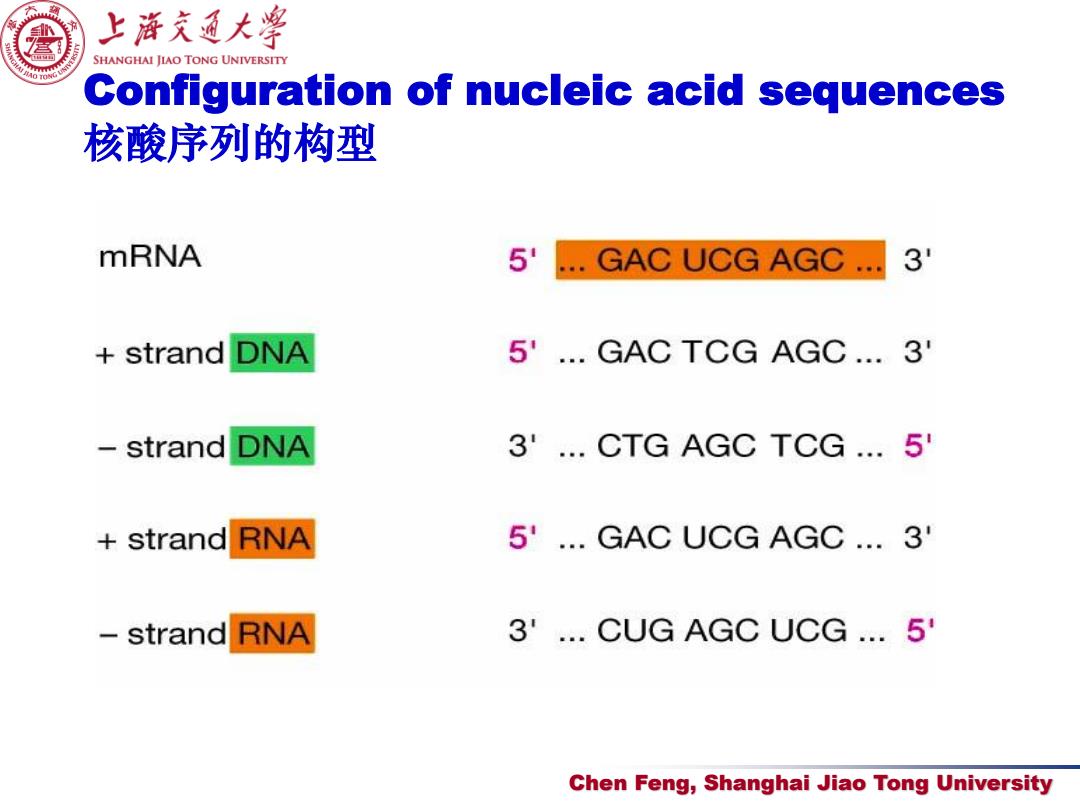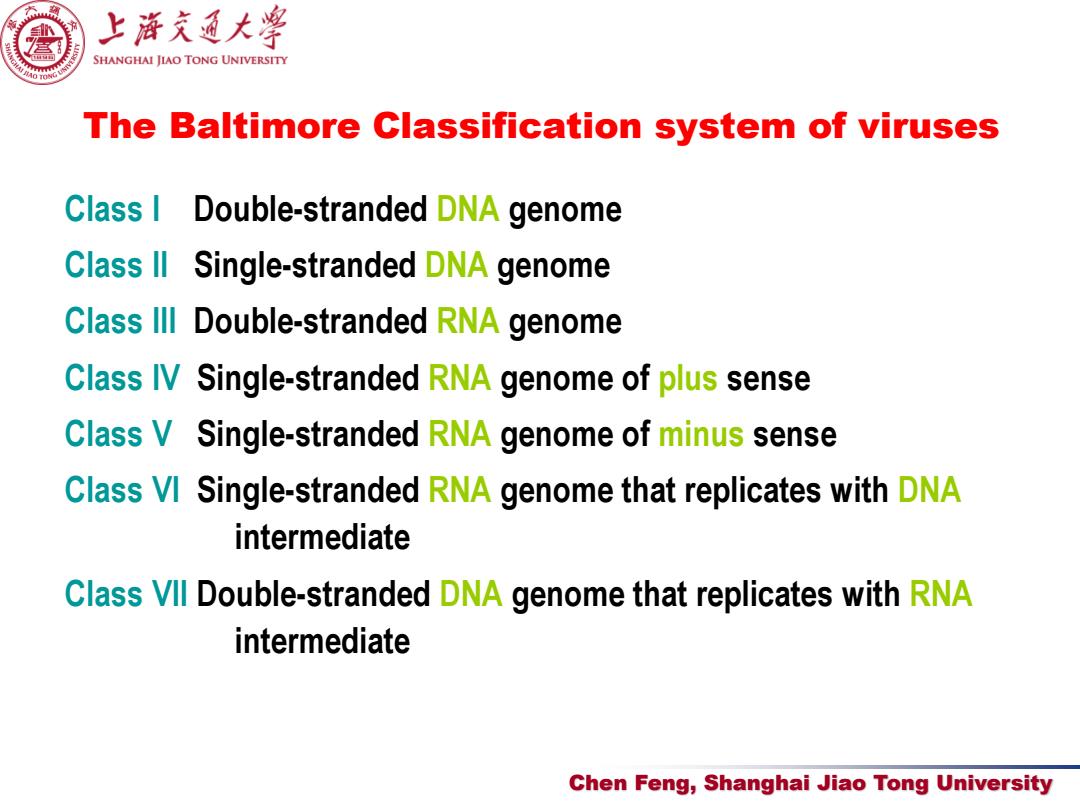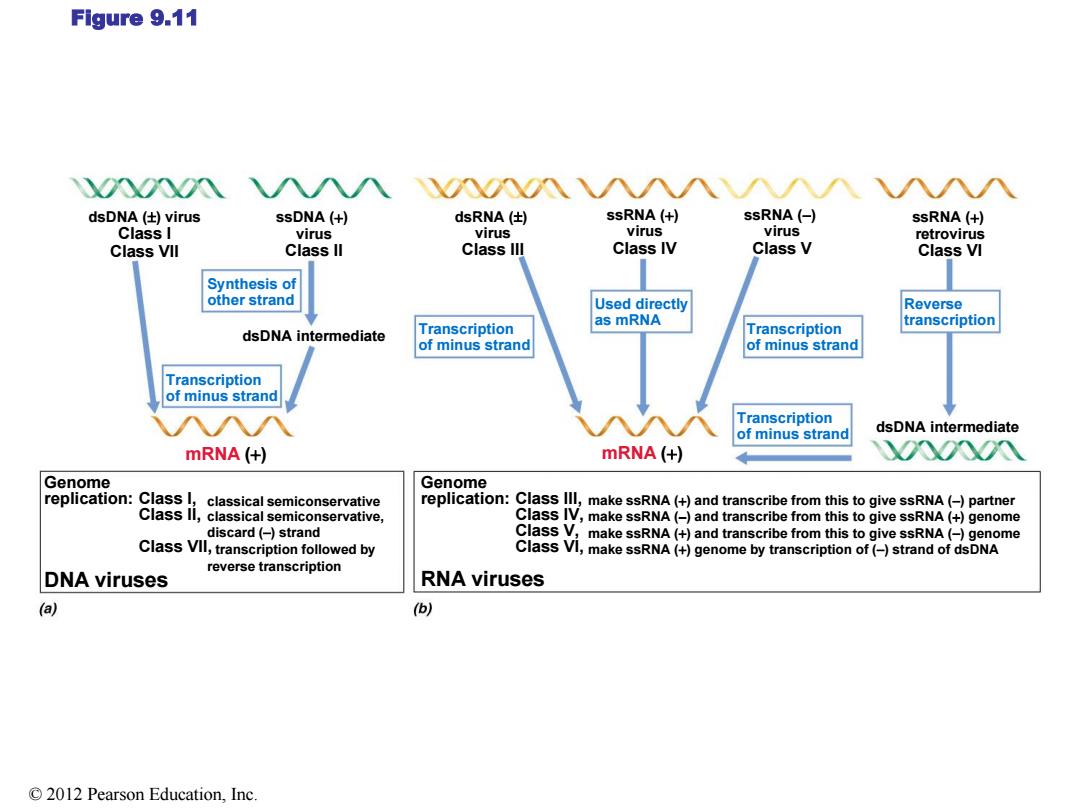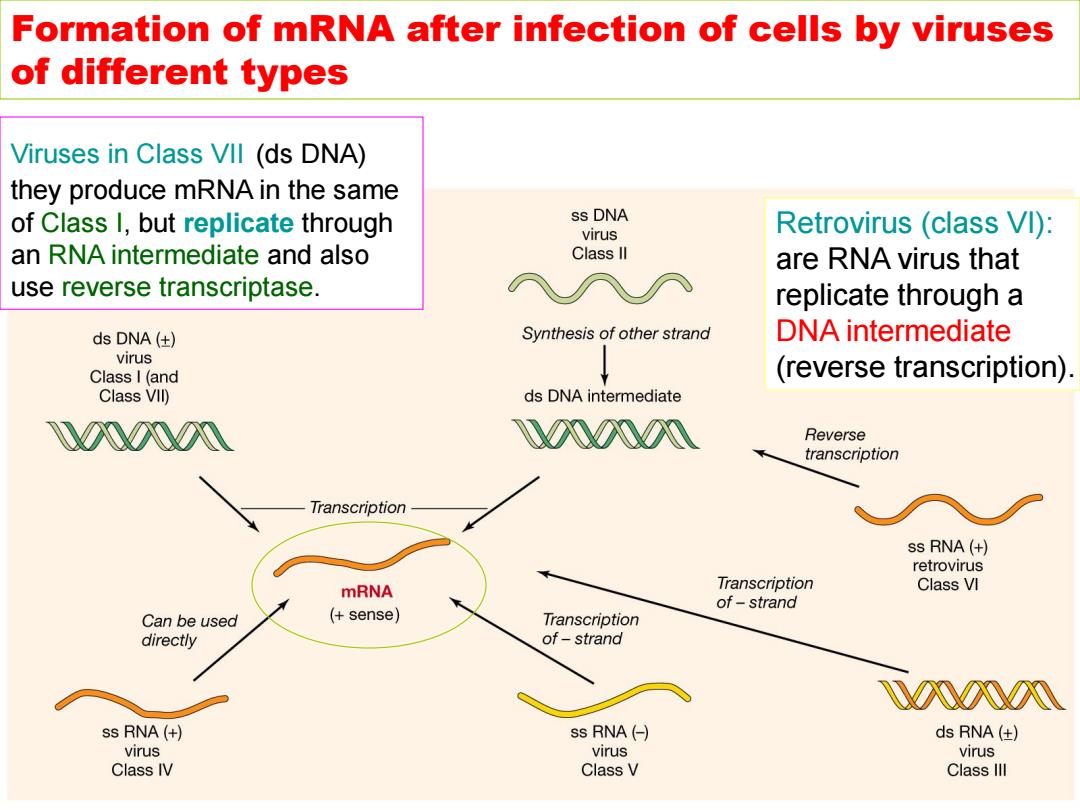
上游充通大¥ SHANGHAI JIAO TONG UNIVERSITY Configuration of nucleic acid sequences 核酸序列的构型 mRNA 5 ..GAC UCG AGC... 3 strand DNA 5'...GAC TCG AGC...3' strand DNA 3'...CTG AGC TCG...5 strand RNA 5...GAC UCG AGC...3' strand RNA 3...CUG AGC UCG...5 Chen Feng,Shanghai Jiao Tong University
Chen Feng, Shanghai Jiao Tong University Configuration of nucleic acid sequences 核酸序列的构型

上游充通大 SHANGHAI JIAO TONG UNIVERSITY The Baltimore Classification system of viruses Class I Double-stranded DNA genome Class ll Single-stranded DNA genome Class Ill Double-stranded RNA genome Class IV Single-stranded RNA genome of plus sense Class V Single-stranded RNA genome of minus sense Class VI Single-stranded RNA genome that replicates with DNA intermediate Class Vll Double-stranded DNA genome that replicates with RNA intermediate Chen Feng,Shanghai Jiao Tong University
Chen Feng, Shanghai Jiao Tong University The Baltimore Classification system of viruses Class I Double-stranded DNA genome Class II Single-stranded DNA genome Class III Double-stranded RNA genome Class IV Single-stranded RNA genome of plus sense Class V Single-stranded RNA genome of minus sense Class VI Single-stranded RNA genome that replicates with DNA intermediate Class VII Double-stranded DNA genome that replicates with RNA intermediate

Figure 9.11 0NONONAA0AUAAAA dsDNA(仕)virus ssDNA (+ dsRNA(住) SsRNA(+) ssRNA(-) SSRNA (+ Class I virus virus virus virus retrovirus Class Vll Class ll Class Ill Class IV Class V Class VI Synthesis of other strand Used directly Reverse dsDNA intermediate Transcription as mRNA Transcription transcription of minus strand of minus strand Transcription of minus strand Transcription of minus strand dsDNA intermediate mRNA(+) mRNA(+) XX0 Genome Genome replication:Class I, classical semiconservative replication:Class lll,make ssRNA(+)and transcribe from this to give ssRNA(-)partner Class ll,classical semiconservative, Class IV,make ssRNA(-)and transcribe from this to give ssRNA(+)genome discard (-)strand Class V,make ssRNA(+)and transcribe from this to give ssRNA(-)genome Class VIl,transcription followed by Class VI,make ssRNA(+)genome by transcription of(-)strand of dsDNA reverse transcription DNA viruses RNA viruses (a) (b) 2012 Pearson Education,Inc
Figure 9.11 dsDNA () virus Class I Class VII ssDNA () virus Class II dsRNA () virus Class III ssRNA () virus Class IV ssRNA () virus Class V ssRNA () retrovirus Class VI dsDNA intermediate dsDNA intermediate Synthesis of other strand Transcription of minus strand Transcription of minus strand Transcription of minus strand Transcription of minus strand Used directly as mRNA Reverse transcription mRNA () mRNA () Genome replication: Class I, Class II, Class VII, DNA viruses Genome replication: Class III, Class IV, Class V, Class VI, RNA viruses classical semiconservative classical semiconservative, discard () strand transcription followed by reverse transcription make ssRNA () and transcribe from this to give ssRNA () partner make ssRNA () and transcribe from this to give ssRNA () genome make ssRNA () and transcribe from this to give ssRNA () genome make ssRNA () genome by transcription of () strand of dsDNA © 2012 Pearson Education, Inc

Formation of mRNA after infection of cells by viruses of different types dsDNA virus(class I):production of ssDNA virus(class Il): mRNA can occur as it would from have a double-stranded the host genome. ss DNA DNA intermediate during virus Class Il replication,and intermediate is used for transcription. ds DNA(±) Synthesis of other strand virus Class I (and Class VIl) ds DNA intermediate 100 Reverse transcription SsRNA(+)virus (class IV):the RNA Transcription strand can serve ss RNA (+ directly as mRNA. retrovirus mRNA Transcription Class VI of-strand Can be used (sense) Transcription direc ssRNA(-)virus(class V): of-strand the complementary dsRNA virus(class Ill):the plus/+strand is complementary plus/+ Ss RNA (+ synthesized by RNA strand is synthesized by ds RNA(±) virus virus Class IV polymerase and used as RNA polymerase and used Class lll mRNA. as mRNA
Formation of mRNA after infection of cells by viruses of different types dsDNA virus (class I): production of mRNA can occur as it would from the host genome. ssDNA virus (class II): have a double-stranded DNA intermediate during replication ,and intermediate is used for transcription. ssRNA(+) virus (class IV): the RNA strand can serve directly as mRNA. dsRNA virus (class III): the complementary plus/+ strand is synthesized by RNA polymerase and used as mRNA. ssRNA(-) virus (class V) : the complementary plus/+ strand is synthesized by RNA polymerase and used as mRNA

Formation of mRNA after infection of cells by viruses of different types Viruses in Class Vll (ds DNA) they produce mRNA in the same of Class l,but replicate through ss DNA virus Retrovirus(class VI): an RNA intermediate and also Class Il are RNA virus that use reverse transcriptase. replicate through a ds DNA(±) Synthesis of other strand DNA intermediate virus Class I (and (reverse transcription). Class VIl) ds DNA intermediate V000 Reverse transcription Transcription ss RNA (+ retrovirus mRNA Transcription Class VI of-strand Can be used (+sense) Transcription directly of-strand 100 Ss RNA(+) ss RNA ( ds RNA(±) virus virus virus Class IV Class V Class lll
Formation of mRNA after infection of cells by viruses of different types Retrovirus (class VI): are RNA virus that replicate through a DNA intermediate (reverse transcription). Viruses in Class VII (ds DNA) they produce mRNA in the same of Class I, but replicate through an RNA intermediate and also use reverse transcriptase